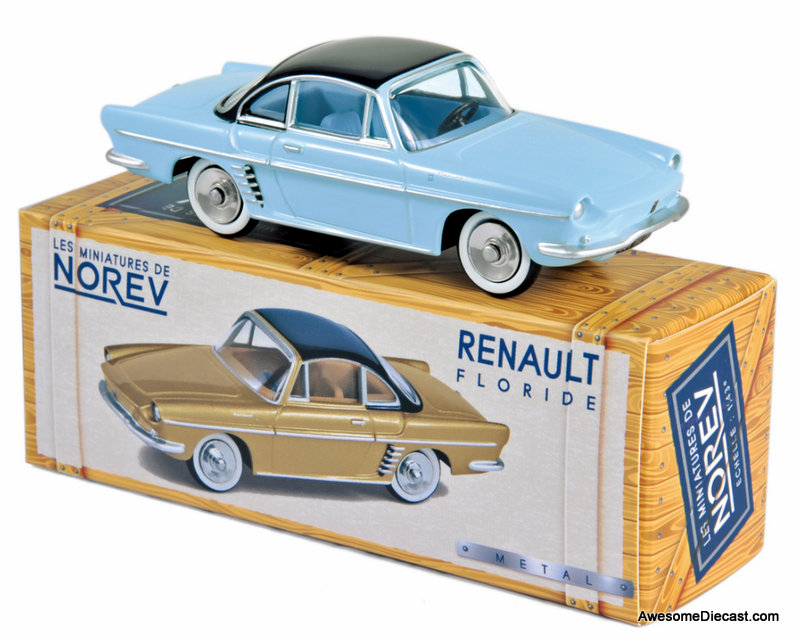Norev
Norev 1:43 1959 Renault Floride Coupe, Blue/Black

Norev 1:43 1959 Renault Floride Coupe, Blue/Black
$940.01
In the mid -1950s, the Renault range was made up of two models: the 4CV , small, cheap and lively (just think of its success in the sports field), and the largest and most elegant Frégate . A rather small range, which internally presented a void to fill. For this reason, the Renault executives launched a project intended for the production of a niche car that inspired cheerfulness, light-heartedness, the desire for holidays and free time, a car that would combine the economy of a Renault Dauphine (now close to debut) with elegance of a convertible. In the intentions of Pierre Dreyfus, the new Renault president who recently succeeded the late Lefaucheux, the car should have had a commercial outlet also in the United States . For this Dreyfus left for a trip to the States together with Fernand Picard , head of project development. Upon his return to France, Dreyfus had a meeting with the Italian designer Luigi Segre , president of Ghia , to whom he commissioned the development of a low-end sports car, based on the Dauphine, which could also meet the tastes of the American public. Project 1092 therefore started. From the outset, Segre made use of the advice of the young designer Virgil Exner Jr., son of the better known Virgil Exner who worked at Chrysler in those years . Exner's advice was important as it could act as a link between Segre's ideas and the tastes of the overseas public. The young Exner sent some drafts to Segre, who turned them to Renault. The leaders of the Casa della Losanga were immediately convinced and therefore gave way to the creation of the first prototypes. A first clay maquette was made by the general manager of Ghia, Giovanni Savonuzziand, after approval by the Renault Board of Directors, the construction of the first prototype, called Dauphine Sport , was started . And here the problems began: for the first prototype, Segre subcontracted the contribution of Pietro Frua , still considered the stylistic father of Floride . But, shortly after the realization of the Dauphine Sport prototype ,a dispute arose between Virgil Exner Jr, Luigi Segre and Pietro Frua for the authorship of the project. Within a short time, another dispute arose, this time between Segre and Frua, since Frua was not paid by Segre for his performance. Thus, the dispute continued in other guises: Frua, now frustrated by the vain attempts to contact Segre, sold his project to the Swiss Ghia-Aigle, born by the will of the same Ghia and later evolved autonomously until becoming independent (and therefore competitor of the same Ghia). So it was that at the Geneva Motor Show in March 1958, the Swiss company exhibited the prototype, renamed Dauphine GT. When Dreyfus, wandering between the stands, passed in front of that of Frua and Ghia-Aigle, he demanded explanations from the Italian designer, who told the whole story. Dreyfus, highly annoyed, went to Segre, also present at the Geneva event, and ordered him to find a solution immediately. Subsequently, the tensions between Segre and Frua continued until a lawsuit that would drag on until the early sixties .
The events that took place at the Geneva Motor Show in 1958 meant that the public was thinking of an almost imminent debut of Renault's new "discovery", but the times were not yet fully ripe and, for the official debut of the definitive model, the curious should have wait until the following autumn, when the definitive Floride would be presented at the Paris Motor Show . And in any case, the presentation was still not enough to convince the Renault leaders, so much so that actual production would have had to wait until May 1959 . And here too some problems arose: the enormous success of Dauphine meant that the Flins plant, where the latter was produced, could only be exploited to support the strong market demand towards Dauphine itself , so that Floride's production had to be diverted to two external companies, namely the Chausson and Brissonneau et Lotz bodies . The final assembly operations were delegated to the latter. Marketing began two months later in July.
The Floride was offered from the outset both as a two-seater dry spider and as a coupé : in both cases, its line roughly resumed what were the typical features of sports cars, with a rather pointed and sharp grille . The large round headlights half incorporated in the muzzle were instead a feature of most of the cars of those years, especially the small and medium-sized sports cars. Like the Dauphine from which it was derived, the Floride also had a front bumper that arched upwards in the center, so as to allow access to the spare wheel compartment, obtained at that point. The hoodfront, under which the trunk was located, was smooth and without ribs of any kind. The side was perhaps the most original part of the entire car body: from the front, which initially took up the simplicity of the front, a chromed molura started that cut the entire side in two. Also in the sill there was a thin chrome line that highlighted that area. The rear part of the side was instead characterized by an almost vertical air intake and cut in two by the main chrome line. As for the tail, the two rear fins were evidentwhich housed the two elongated ovoid-shaped lighthouses, embellished with a silver-colored frame. The engine compartment cover was also smooth and free of ribs or any other element that disturbed its appearance. Between the two fins there was the large grill for extracting heat from the engine compartment. Characteristic of the Floride's tail was also the very enveloping rear bumper.
The interior of Floride betrayed the relationship with the Dauphine, especially as regards the dashboard, directly derived from the latter. The two-spoke steering wheel was devoid of horn, housed instead in a lever located to the left of the steering wheel. Being a rear-powered car, the comfort of a large trunk was missing, which is present in most other small spiders or coupes with traditional architecture (front engine, rear-wheel drive). In front, however, there was a compartment for loading luggage, which, although penalized by the cumbersome presence of the wheel arches, still managed to offer a capacity of 240 liters, to which were added the 175 liters of the area behind the two rear seats.
The Floride picks up the floor and mechanics from the Dauphine, thus presenting a similar mechanical configuration, with engine and rear wheel drive : this solution, given the evident imbalance in the distribution of the masses between the rear axle and the front axle, made the Floride rather difficult to steer in the most difficult curves . The engine was the classic 4- cylinder 845 cm³ , here in the version also mounted under the hood of the Dauphine Gordini . This power unit was capable of delivering 38 HP DIN of maximum power (40 HP SAE) at 5200 rpm. The power was in the carburetor single body Solex. The exchangeit was manual, initially with only 3 gears, the first of which was not synchronized. The braking system was also quite simple, providing the drums on the four wheels, while the steering was cogwheel. The suspension scheme included an independent wheel front axle with triangular arms and an independent wheel rear axle with oscillating axle shafts. Helical springs and telescopic hydraulic shock absorbers were mounted on both axles .









